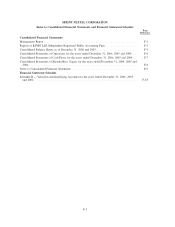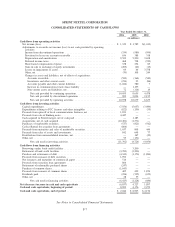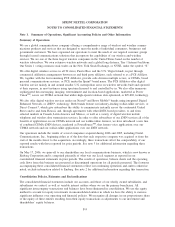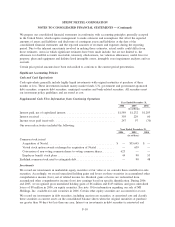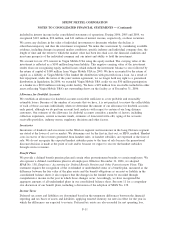Sprint - Nextel 2006 Annual Report Download - page 88
Download and view the complete annual report
Please find page 88 of the 2006 Sprint - Nextel annual report below. You can navigate through the pages in the report by either clicking on the pages listed below, or by using the keyword search tool below to find specific information within the annual report.included in interest income in the consolidated statements of operations. During 2006, 2005 and 2004, we
recognized $122 million, $96 million, and $11 million of interest income, respectively, on these securities.
We assess any declines in the value of individual investments to determine whether the decline is
other-than-temporary and thus the investment is impaired. We make this assessment by considering available
evidence, including changes in general market conditions, specific industry and individual company data, the
length of time and the extent to which the market value has been less than cost, the financial condition and
near-term prospects of the individual company and our intent and ability to hold the investment.
We account for our 47% interest in Virgin Mobile USA using the equity method. The carrying value of the
investment is reflected as a $180 million long-term liability. This negative carrying value of the investment
results from our recognizing equity method losses which reduced the investment balance to zero followed by
the return of capital of $180 million from Virgin Mobile USA in 2005. We have accounted for the return of
capital as a liability as Virgin Mobile USA funded the distribution with proceeds from a loan. As a result of
this repayment, under the terms of the joint venture agreement, we no longer hold any right to a guaranteed
distribution in liquidation. In 2006, we extended Virgin Mobile USA credit via our $50 million participation
as a lender in a $100 million revolving credit facility. We have a $29 million loan receivable included in other
assets reflecting Virgin Mobile USA’s net outstanding draws on the facility as of December 31, 2006.
Allowance for Doubtful Accounts
We establish an allowance for doubtful accounts receivable sufficient to cover probable and reasonably
estimable losses. Because of the number of accounts that we have, it is not practical to review the collectibility
of each of those accounts individually when we determine the amount of our allowance for doubtful accounts
each period, although we do perform account level analysis with respect to certain of our long distance
customers. Our estimate of the allowance for doubtful accounts considers a number of factors, including
collection experience, current economic trends, estimates of forecasted write-offs, aging of the accounts
receivable portfolios, industry norms, regulatory decisions and other factors.
Inventories
Inventories of handsets and accessories in the Wireless segment and inventories in the Long Distance segment
are stated at the lower of cost or market. We determine cost by the first-in, first-out, or FIFO, method. Handset
costs in excess of the revenues generated from handset sales, or handset subsidies, are expensed at the time of
sale. We do not recognize the expected handset subsidies prior to the time of sale because the promotional
discount decision is made at the point of sale and/or because we expect to recover the handset subsidies
through service revenues.
Benefit Plans
We provide a defined benefit pension plan and certain other postretirement benefits to certain employees. We
also sponsor a defined contribution plan for all employees. Effective December 31, 2006, we adopted
SFAS No. 158, Employers’ Accounting for Defined Benefit Pension and Other Postretirement Plans. This
statement requires the recognition of the overfunded or underfunded status of a benefit plan, measured as the
difference between the fair value of the plan assets and the benefit obligations as an asset or liability in the
consolidated balance sheet; it also requires that the changes in the funded status be recorded through
comprehensive income in the year in which those changes occur. Accordingly, we have recognized the
aggregate amounts of all underfunded plans in our consolidated balance sheet. See note 11 for a comprehen-
sive discussion of our benefit plans, including a discussion of the adoption of SFAS No. 158.
Income Taxes
Deferred tax assets and liabilities are determined based on the temporary differences between the financial
reporting and tax bases of assets and liabilities, applying enacted statutory tax rates in effect for the year in
which the differences are expected to reverse. Deferred tax assets are also recorded for net operating loss,
F-11
SPRINT NEXTEL CORPORATION
NOTES TO CONSOLIDATED FINANCIAL STATEMENTS — (Continued)


